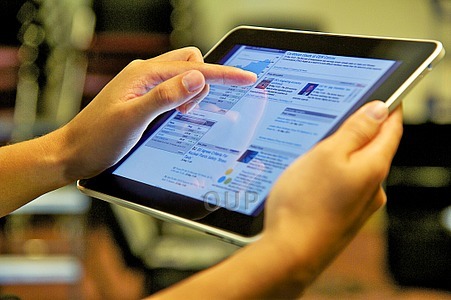
Whenever someone mentions using technology in the classroom, my first reaction is “Why?” And that was my recent reaction to using tablets. Why should students use tablets in the EFL classroom? How does it help them learn better? For me, the key is not the technology, it is learning.
Many teachers already use technology in the classroom. Many also use technology to take learning beyond the classroom. In this environment, I was curious about the role of the tablet in the EFL classroom. So, being a teacher trainer with Oxford University Press, I got some e-books, downloaded them onto my tablet and sat down to answer my own question: How do tablets help students learn better?
A few days and many hours later I had an answer; using a tablet can make learning more personal. The teacher can better appeal to the individual learner, to individual interests, individual learning styles, and individual difficulties.
So, knowing why, the next obvious question is “How?” There are many different activities. Here are two to introduce the use of tablets to your students:
- Writing their own notes
Students can add their own personal notes to different parts of the coursebook or the lesson. For vocabulary or grammar, each student can write their own sentence relating the language to their lives. 25 students in the classroom will have 25 different sentences. This will make the language relevant to each one, expanding on the work done in class. For a reading or listening text, students can write comments or ask questions, individually interacting with the text.
Classroom activity:
After reading a text, ask your students to use the note and write 5 – 10 important words from the text. One week later, ask them to look at the words in the note. Do they remember how the words relate to the topic? If they do, it confirms their reading ability (and memory). If not, they can go back to the text. They may choose to change some of the words, keeping the total to no more than 10.
Equally, students can write 5 – 10 questions about the text, or 5-10 True/False statements. One week later they can use these as a comprehension exercise as they re-read the text. For me, what is important here is that using a tablet, each student is focusing on their own words, their own sentences, their own questions. They are interacting with the language at their own level, based on their individual needs.
Students can also record comments. Instead of writing 5-10 words or sentences related to a text, students can record the words or sentences related to a picture. Later, they look at the picture and listen to their words/sentences. Since the picture is connected to the topic of a lesson, students learn when they choose the words or sentences, when they record them, and when they listen to them later.
- Using the pen tools
Students can use the pen tools to circle, underline, or highlight. In this way, they can focus on specific aspects of a text or language exercise. Again, 25 different students would focus on different words and sentences, personalising their work. For me, the pen tools help students bring out language patterns. Let me give you an example:
Students circle the subject and relate it to the verb, “George and I are”. By highlighting “going to”, students reinforce the “to”, which is something my students easily forget. They can then use another colour to highlight the verb, “throw”. Some students will use the pen to draw an arrow from the subject to the verb.
Classroom activity:
Ask students to do this with the grammatical structures they are learning. This will get them used to using the pen tools. Then, ask them to write sentences about themselves and their life using the structure they are learning. Having highlighted the form of the structure, students will probably make fewer mistakes.
Then, ask them to highlight the different parts in their sentences. This will lead students to notice any mistakes they have made and to be able to correct them.
Conclusion
These are only two activities to get you and your students started. There are many more you can explore as you and your students get used to using tablets in the classroom.
As your students use their tablets, they are personalizing their learning, adding to their lessons. Each student begins from the same starting point, but develops individually, adding their own content, and thus meeting their individual needs and learning preferences.
The key is to focus on learning, to help your students learn better with their